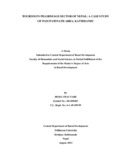Please use this identifier to cite or link to this item:
https://elibrary.tucl.edu.np/handle/123456789/2267| Title: | Tourism in Pilgrimage Sector of Nepal: a Case Study of Pasupatinath Area, Kathmandu |
| Authors: | Chautare, Hema |
| Keywords: | Tourism;Study;Areas;Rural development |
| Issue Date: | 2019 |
| Publisher: | Central Department of Rural Development |
| Abstract: | pay homage. Thousands of people visit to Pashupatinath daily. But, there are some people who are living permanently at Pashupatinath premises from many years ago. 2,210 people were lived at Pashupati area during the Survey of the census of 1910. Among them 48 percent were male and 52 percent female. Now a day the separate data of total population of Pashupati Area including continuum zone is not available. But the total population of monumental zone was 1331 in 1994. The main objective of the study is to analyze the importance of Pashupatinath in Pilgrimage Tourism, identify the problems The project report has been conducted entitled “Tourism in Pilgrimage Sector of Nepal: A Case Study of Pasupatinath Area, Kathmandu”. Pashupatinath is the major destination for the people to and suggest the measures to promote the pilgrimage tourism in Nepal. Two sets of questionnaires were prepared to collect the information with 230 pilgrims and to analyse the economic activities related to the pilgrims at Pashupatinath. Secondary data has been collected from the different books and research articles. T. U. central library, ICIMOD library, Indian Embassy library, Galaxy library and official record of Pashupati Area Development Trust and Nepal Tourism Board have been provided different books, articles and records for this study. Tourism is developed from Tirtha Yatra in Hindu civilization. Mostly Himalayan Region of Nepal and India is the good destinations for the pilgrimage tourism. People want to visit different natural and cultural places for the purpose of pleasure and to devote them in to the Lord. Tourism is arisen from the movement of people to various destinations, which involves two basic activities: the journey to the destination and activities at the destination. Therefore tourism is the use of leisure for the purpose of pleasure. Pashupatinath is the major destination for Hindu pilgrims. They visited this shrine from the ancient time of the history of Nepalese tourism. Generally, the flow of visitors is high on Mondays and Saturdays because Monday is the birthday of lord Shiva and Saturday is the public holiday of Nepal. Pilgrims are facing different problems during their visit in Pashupatinath. PADT is planning to manage the problems of pilgrims at Pashupatinath. It also planned to develop the landscape of this area. The main purpose of pilgrims visited at Pashupatinath is pilgrimage. Majority (49%) of the visitors' main purpose was pilgrimage followed by holiday pleasure (13%). Among the visitors, majority of the respondents were between 20-29 years age group. Nature of occasional visit of pilgrims was more than daily and weekly visitors. Forty-nine percent of the visitors reported that they visit Pashupatinath occasionally. Likewise, 84 percent of the visitors are found to be visiting Pashupati more times but 10 percent of the respondent visitors were at first time and 6 percent were there at second time. About 60 percent of the visitors were coming there in group. Fifty-four percent of visitors reported to have visited Pashupatinath from another sacred place. Forty-six percent of the pilgrims were female and the rest 54 percent were males. The trend of visit was found to be more on Mondays and Saturdays. About 27 percent Nepalese visitors visited from Kathmandu districts, 7 percent each from Bhaktapur, Morang, Jhapa and Lalitpur district visited Pashupatinath. 296 people were getting employment in 188 different types of shops. Among them 117 were shops of religious goods and 28 of them were shops of non-religious goods. Pashupati Area Development Trust has been divided this region into three parts for the overall development of this area. This area is divided into core area, consument area and continuum zone. Its total coverage is 96.4 hector. PADT is doing different work for the overall development of this area. By the patience of the pilgrims, it can be understood that people have great faith upon lord Shiva and Pashupatinath. They responded Pashupatinath as a first ranked holy shrine of Hindu. Most of the respondents visited in group at Pashupatinath. Majority of pilgrims visited Pashupatinath after visiting another sacred place. This shows Hindu pilgrims visit different sacred place to worship different god and goddesses. Majority of pilgrims visited at Pashupatinath visit from the districts around Kathmandu Valley and the districts of Tarai region. |
| URI: | http://elibrary.tucl.edu.np/handle/123456789/2267 |
| Appears in Collections: | Rural Development |
Files in This Item:
| File | Description | Size | Format | |
|---|---|---|---|---|
| Cover Page(5).pdf | 32.21 kB | Adobe PDF |  View/Open | |
| CHAPTER (1).pdf | 326.95 kB | Adobe PDF |  View/Open |
Items in DSpace are protected by copyright, with all rights reserved, unless otherwise indicated.
